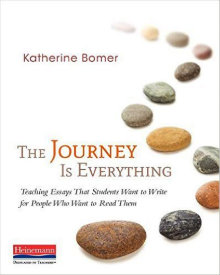Teaching Essays That Students Want to Write
The Journey Is Everything: Teaching Essays that Students Want to Write for People Who Want to Read Them
By Katherine Bomer
(Heinemann, 2016 – Learn more)

Anticipate your need for lots of post-its and a highlighter when reading Katherine Bomer’s The Journey Is Everything. At least, I did.
I find that I need to annotate and write to help me process great professional texts because I end up in such a state of reflection that I know I will return to these ideas. The Journey Is Everything has made me a more aware teacher and writer. Bomer presents a charming history of essay alongside many examples of essaying in the world.
 More about the book
More about the book
We are provided with the foundational features of essay, where to find them in the real world, and how to name and develop craft as well as how to shape and structure an essay.
We find out how to help young writers name and revise their thinking, reveal truth, and weave in other voices as well as draft, fine-tune, and revise. Yet this is not a book bent on formula. Actually, inspired by the life and writing of Montaigne, Bomer provides concrete suggestions that help teachers move away from formula.
For example, deep into the text, a phrase coined by literary researcher Brian Cambourne, “the privilege of struggling,” encapsulates the esprit de corps of writing not bound by checklists and must-haves. For me, this is the touchstone moment in the book. Allowing, and even encouraging, struggle is the heartbeat within the decisions we must make to help young writers grow.
Bomer explains:
In schools, we rush to fill those moments of confusion students sometimes experience, or we insist that kids, especially the ones who ‘struggle’ with writing, need more structure and scaffolds to prop them up.”
Having reread the book several times (sketchnoting it too) and having attended Katherine Bomer’s recent session at the annual NCTE conference, I understand the challenge presented by Bomer as find a way to become comfortable with allowing our kids to sit with difficulty (113).
Of course, a huge component is time. We want to do the right things for our kids. We want our decisions to be research-tested. But where is the time for such important work? Bomer makes the case that we must reclaim that time for our students. Time spent struggling as a writer is a better investment than any rubric, graphic organizer, or formula.
Developing fluency & flexibility as a writer & thinker
Bomer contends that becoming college and career ready is more about developing fluency and flexibility as a writer and thinker (through struggle and uncertainty) than it is in following cookie-cutter structures for any particular mode.
Yet, because argument, exposition, and narrative carry the flag of “college and career ready,” our facilitation of that writing risks becoming a series of transactions – I read this, I see this, I identify this, I write this – which have incidental impact on the future college writers our middle school students are destined to become.
If we are being honest, our decisions have most of their impact on our writing scores in 8th grade. The carryover to college has proven to be minimal.
As a matter of fact, most college writing experiences are framed with such divergent terminologies, expectations, and processes that college writing little resembles the writing done in high school, let alone in middle school. The writing we often swear our students need in order to be college and career ready may not be as helpful as we are led to believe.
It isn’t the mode of writing per se that matters the most, but the growth of the writer as a thinker. As Bomer contends, the best way to reach that end is for the teacher to create conditions for the unexpected journeys we will allow each of our writers to explore.
A view from college
For my own satisfaction, I reached out to Liz Mathews, a professional writing tutor at Villanova University, with some of Bomer’s ideas. Mathews agrees that students enter college with a real “culture shock” when it comes to writing:
They seem to have spent a lot of time in high school exploring and reporting on what texts and disciplines say (e.g. repeating information) and in college they are asked to critically engage with their personal insights into why and how those texts, time periods, results, etc. produce that information…college writing is persuasive writing primarily and students need help adjusting to that.”
Because of the strain of state assessments, we bend under systems of mechanized literacy. We play a role and check for the parts of the specific modes of essay: where is your thesis; where is your support, where is your commentary, et al.
We justify our decisions because we know the state assessments are galloping towards us, and our kids will be tested on their ability to construct a proper argument or expository essay. We know that scorers will be looking for things…even though we really don’t know what those things are.
Refocusing on students’ questions
Additionally, we believe that “this” is the writing that matters, and we convince ourselves that our kids will need “this” next year. So our students spend months (across the curriculum) writing to questions that aren’t even their own questions. We rarely provide extended periods of time for them to think (let alone change one’s mind) because the state assessments do not allow for time for thinking, conversation, walking away, collaboration, or anything that real writers do in the real world.
So, Bomer observes, we follow the cue of the state and adopt teaching habits which have “nothing to do with helping kids write better and everything to do with control (31).”
Bomer teaches us not only that essay is not prescriptive, but also that thinking is not prescriptive. Some of our habits in the classroom may actually hinder growth if students do not have time to be messy. If we are to make decisions that move kids towards critical engagement and personal insight as writers, it has to start with how we see the act of writing an essay. The truth of the matter is that growth as a writer happens; it is not made.
No single mode, explicit graphic organizer, or slick digital essay-scoring technology will help teenagers value writing as a process of thinking and discovery, but immersing ourselves in Katherine Bomer’s The Journey Is Everything may just convince more of us to teach writing as a writer – not with formula, but with passion.
Brian Kelley is an 8th grade teacher in Pennsylvania and a co-director of the Pennsylvania Writing & Literature Project. Currently, he serves as a reviewer for Voices in the Middle and has published professional articles in English Journal and California English. Follow Brian on Twitter @_briank_ or his blog Writer. Teacher. Mentor., or subscribe to his weekly education podcast, The Classroom, which models individual and group conferring for teachers.


































